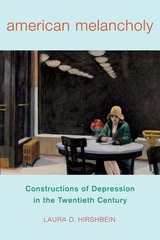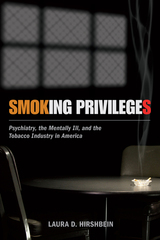2 books about Hirshbein, Laura D.

American Melancholy
Constructions of Depression in the Twentieth Century
Hirshbein, Laura D
Rutgers University Press, 2009
As American Melancholy reveals, if you read about depression anywhere today—medical journal, popular magazine, National Institute of Mental Health pamphlet, or pharmaceutical company drug promotional literature--you will find three main pieces of information either explicitly stated or strongly implied: depression is a disease (like any other physical disease); it is extraordinarily prevalent in the world; and it occurs about twice as frequently in women as in men. Yet, depression was not classified as a disease until the 1980 publication of the American Psychiatric Association's Diagnostic and Statistical Manual-III (DSM-III). How is it that such an illness, thought to affect between 14 and 17 million Americans, was not specifically defined until the late twentieth century?
American Melancholy traces the growth of depression as an object of medical study and as a consumer commodity and illustrates how and why depression came to be such a huge medical, social, and cultural phenomenon. It is the first book to address gender issues in the construction of depression, explores key questions of how its diagnosis was developed, how it has been used, and how we should question its application in American society.
[more]

Smoking Privileges
Psychiatry, the Mentally Ill, and the Tobacco Industry in America
Hirshbein, Laura D
Rutgers University Press, 2015
Current public health literature suggests that the mentally ill may represent as much as half of the smokers in America. In Smoking Privileges, Laura D. Hirshbein highlights the complex problem of mentally ill smokers, placing it in the context of changes in psychiatry, in the tobacco and pharmaceutical industries, and in the experience of mental illness over the last century.
Hirshbein, a medical historian and clinical psychiatrist, first shows how cigarettes functioned in the old system of psychiatric care, revealing that mental health providers long ago noted the important role of cigarettes within treatment settings and the strong attachment of many mentally ill individuals to their cigarettes. Hirshbein also relates how, as the sale of cigarettes dwindled, the tobacco industry quietly researched alternative markets, including those who smoked for psychological reasons, ultimately discovering connections between mental states and smoking, and the addictive properties of nicotine. However, Smoking Privileges warns that to see smoking among the mentally ill only in terms of addiction misses how this behavior fits into the broader context of their lives. Cigarettes not only helped structure their relationships with other people, but also have been important objects of attachment. Indeed, even after psychiatric hospitals belatedly instituted smoking bans in the late twentieth century, smoking remained an integral part of life for many seriously ill patients, with implications not only for public health but for the ongoing treatment of psychiatric disorders. Making matters worse, well-meaning tobacco-control policies have had the unintended consequence of further stigmatizing the mentally ill.
A groundbreaking look at a little-known public health problem, Smoking Privileges illuminates the intersection of smoking and mental illness, and offers a new perspective on public policy regarding cigarettes.
[more]
READERS
Browse our collection.
PUBLISHERS
See BiblioVault's publisher services.
STUDENT SERVICES
Files for college accessibility offices.
UChicago Accessibility Resources
home | accessibility | search | about | contact us
BiblioVault ® 2001 - 2024
The University of Chicago Press









